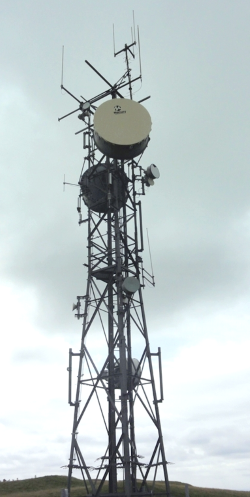Large structures such as buildings and wind farms affect wireless services in their vicinity. A common example of this is the weakening of mobile phone signal in the vicinity of large buildings.
Ofcom produced guidelines in 2009 titled ‘Tall structures and their impact on broadcast and other wireless services’. These guidelines are a useful resource for building planners and wind turbine developers, or anyone else interested in this issue.
The guidelines are lengthy and in some parts quite technical. Below is a summary of the key points set out in the Ofcom guidance.
- It is recommended that potential impact on wireless services is considered at the design and planning stages of a project.
- The services that could be affected by a large structure include broadcast services for the public (e.g. TV), business radio (e.g. voice or data communications) or microwave links (e.g. part of a mobile phone network.)
- Problems are most likely for structures that are significantly taller than those around it or structures on high terrain.
- Issues arise when a structure is on or close to the path between transmitter and receiver.
- The two mechanisms that can adversely affect a wireless service are Signal Blocking and Reflection.
- Signal blocking occurs when a receiver is in the shadow of a large structure, which has the effect of reducing the strength of the received signal.
- Reflection occurs when signal bounces off the structure and is subsequently received at a different location. The outcome is that the signal will be received twice – once via the direct path from the transmitter and once via the reflected path caused by the structure. The problem is that the reflected path is longer and therefore the reflected signal arrives later than the direct one, which can cause interference.
- Reflection issues are of more concern to analogue transmissions than digital ones.
- The reflection zone (i.e. that is the area where reflected signals may cause problems) can be thought of as circular. However, if the receiving aerial is directional (i.e. optimised for receiving signals from a particular direction), the reflection zone is shaped more like a keyhole, that is a circle around the structure with a widening ‘slot’ shape in the shadow of the structure.
- Interference in the circular portion of the keyhole typically does not occur beyond 500 metres.
- Interference in the ‘slot’ portion of the keyhole typically does not occur beyond 5 kilometres.
- These distances are illustrated in the figure below. In this scenario the transmitter would be to the left. Reflection occurs when the transmitted.

- Reports of new structures affecting radio reception are rare, but possible.
- High frequency fixed links (such as microwave) are more likely to be affected by signal blocking.
- Lower frequency fixed links (such as telemetry links) can also be affected by reflections.
- As a rule of thumb, if a new development is of a similar height to the surrounding structures it is unlikely to affect signals in the area.
- Where possible impacts are identified or suspected, a desktop assessment and/or reception survey can be undertaken by a suitably competent consultant organisation.
- Specifically with regard to fixed links and wind farms, Ofcom offers a service whereby developers are provided with the details of potentially affected link operators.
How We Can Help
We offers a comprehensive range of assessment and support options for developers of buildings and/or wind farms with regard to wireless and broadcast services. We can provide:
- Comprehensive assessment of potential impacts on fixed links, in accordance with Ofcom guidelines.
- Comprehensive assessment of other broadcast systems.
- Desk based analysis and reception surveys.
- Mitigation reports.
- General support.
- Stakeholder consultation.
- Attendance at meetings.
Reference
Ofcom, 2009, Tall structures and their impact on broadcast and other wireless services.

